|
|
ARTHROPODS:
Insects»
Spiders»
Centipedes»
Millipedes»
Sowbugs»
Harvestmen»
Mites
& Ticks»
Scorpions»
Identification
Tips»
About
the Critter Files»
Links» |
|
|
|
 |
SHEET-WEAVING
SPIDERS
Critter
Files/Spiders/Sheet-Weaving Spiders
By Kelton Welch, Rachael Mallis, and Julie Peterson
University of Kentucky Department of Entomology |
| |
|
Sheet-Weaving
Spiders,
also known as Linyphiid spiders (from the scientific
family name Linyphiidae) are small spiders (less than 1 centimeter
long) with eight eyes that typically construct webs on or close
to the ground. Some forest-dwelling species construct webs in trees
using leaves or needles as support structures. They are very abundant
throughout the Northern Hemisphere, but, because they are so small,
many people do not know about them.
Linyphiid webs are not
tidy spirals, like orb-webs, but are tangled networks of silken
threads arranged in either a three-dimensional mass (a tangle web,
very similar to a cob-web, but usually smaller) or a two-dimensional
sheet (a sheet web). Unlike orb-weavers, many linyphiids do not
use sticky silk in their webs. This means that their webs either
ensnare prey by tangling it up; or allow the spider to find their
prey by vibrations in the web without actually ensnaring the prey
at all.
Male and female linyphiid
spiders can be differentiated by size (males are usually somewhat
smaller and more slender than females) and by their palps (extra
limbs near the spider’s mouth). Female palps are small and
thin. Male palps end in large, bulbous extensions that they use
for mating. |
| |
 Figure
1 Palps of female (left) and male (right) linyphiid spiders (K.
Welch 2009)
Figure
1 Palps of female (left) and male (right) linyphiid spiders (K.
Welch 2009) |
|
| SIZE:
Body length less than 1cm |
| |
| LIFE
CYCLE |
|
Most linyphiids
probably live only one year. Many may even live for only a few months.
Eggs are laid in silken sacs in the web or hiding in leaf litter on
the ground. There can be just a few, or many dozen eggs in a single
egg sac, depending on species and individual. Like all spiders, linyphiids
develop through simple metamorphosis: spiderlings look like tiny adult
spiders (but with lighter coloration), and shed their outer skin in
order to grow.
Some species mate and lay eggs throughout the year, while others
have more discreet mating seasons. Both eggs and adults have been
known to overwinter, and some species may even build webs to catch
prey in the cold winter months. |
| ECOLOGY |
|
Linyphiid spiders are
among the most common types of arthropod predators in crop fields.
Webs can be attached to trees, grass, fenceposts, leaf litter or
even just on the soil. There are many insects and other arthropods
in the soil (such as springtails) that these spiders can consume.
They will also eat flies, aphids, leafhoppers, other spiders, and
tiny wasps.
Linyphiid spiders will
build their webs at night (sometimes taking several consecutive
nights to complete the web), and will stay at one web location for
several days or even longer. Because their webs are more “expensive”
than orb-webs in terms of the amount of silk used, they do not change
web-sites as frequently.
Linyphiid spiders are
also known to balloon regularly. A ballooning spider extends a long
line of silk from its spinnerets, and floats away when the wind
catches the line. This allows them to move rapidly across long distances,
sometimes even thousands of miles! Although many kinds of spiders
balloon, linyphiids are thought to balloon much more regularly.
Furthermore, whereas usually only immatures of other spiders balloon
regularly, adult linyphiids will readily balloon as well.
|
| |
| PEST
STATUS |
|
Linyphiid
spiders are not considered pests. They are not known to bite people.
They feed on many agricultural pests, such as aphids and leafhoppers,
and they are common in many crop fields, so they may actually be
beneficial for farmers. |
| |
| COMMON
KENTUCKY SHEET-WEAVING SPIDERS |
|
| We have many species of
linyphiid spiders in Kentucky, but most can only be identified under
a microscope. Listed below are some of the most common and most recognizable
species. No common names are listed because very few linyphiids even
have common names. |
|
|
Tennesseellum
formicum
GENUS and SPECIES:
Tennesseellum formicum
One of Kentucky's most
common spiders is a sheet-weaver called Tennesseellum formicum.
This spider is about 2 millimeters long. It can be found in grass,
leaf litter or crops, and it tends to prefer disturbed habitats
(such as crops that are harvested or mowed regularly), bare ground
or patchy vegetation. Its webs are often 5–6 centimeters in
diameter. It can be found throughout the spring and summer. |
| |
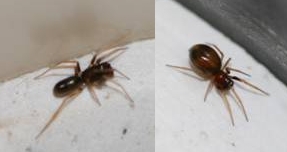 T.
formicum male (left) & female (right) (K. Welch 2009)
T.
formicum male (left) & female (right) (K. Welch 2009) |
|
|
|
Erigone
autumnalis
GENUS and SPECIES:
Erigone autumnalis
Kentucky is home to a
very, very tiny spider called Erigone autumnalis. This
spider is usually 1 or 1.5 millimeters long. Its tangled webs are
also very tiny, often no bigger than a quarter. It can be found
in leaf litter and on bare soil. E. autumnalis can be found
throughout the year (even sometimes in winter). This spider is unique
in that the male spiders are larger than the female spiders. |
| |
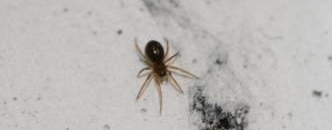 E.
autumnalis (K. Welch 2009)
E.
autumnalis (K. Welch 2009) |
|
|
|
Grammonota
inornata
GENUS and SPECIES:
Grammonota inornata
Although Grammonota
inornata is a close relative of E. autumnalis (above),
it is much larger (although, at 3 mm, it’s still a very small
animal). It builds tangle webs and sheet webs, with a diameter of
3–4 cm, and a height of about 1 cm and often places them at
the very base of a plant stem. It is active throughout the spring
and summer.
|
| |
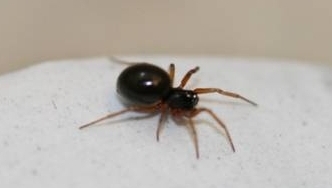 G.
inornata (K. Welch 2009)
G.
inornata (K. Welch 2009) |
|
|
|
Florinda
coccinea
GENUS and SPECIES:
Florinda coccinea
Sometimes called the “red
grass spider,” because of its bright color, this spider is
quite large for a linyphiid (5–6 mm), and is easily spotted.
It can be recognized by the black tubercle (bump) at the end of
its abdomen (smaller picture, arrow). It builds webs in grass, usually
a few centimeters off the ground. The web is a sheet about 10 centimeters
across, but with a large tangle above the sheet to knock down any
passing flies into the sheet below. Florinda is most common
in late summer, especially August.
|
| |
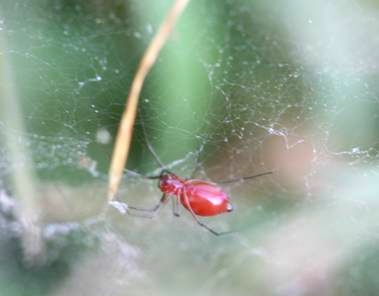 F.
coccinea (K. Welch 2009)
F.
coccinea (K. Welch 2009) |
| |
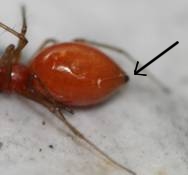 F.
coccinea abdomen (K. Welch 2009)
F.
coccinea abdomen (K. Welch 2009) |
|
|
|
Pityohyphantes
costatus
GENUS and SPECIES:
Pityohyphantes costatus
These spiders are commonly
called “hammock spiders” and are some of the largest
linyphiids in North America. Typically adults are 6-7mm in length,
but some specimens have been as large as 9mm. In Kentucky, these
have been collected on hemlock trees. It builds its webs in lower
branches of trees, on shrubs and fences, forming a large flat sheet
with a small barrier web built above the sheet. It is active in
spring and early summer as adults. An interesting fact about this
species is that it hibernates or overwinters under loose bark and
stones as adults or penultimate instars (the last stage before adulthood).
|
| |
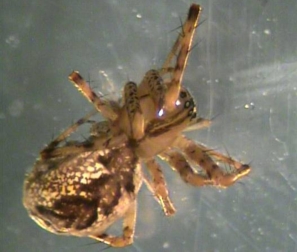 P.
costatus (R. Mallis 2009)
P.
costatus (R. Mallis 2009) |
|
|
|
Frontinella
pyramitela
GENUS and SPECIES:
Frontinella pyramitela
These spiders are commonly
called “bowl and doily spiders” and build neatly crafted
webs. The webs consist of a bowl-shaped cup and underneath this
is a flat, typically horizontal sheet. Sometimes above the bowl
it weaves a maze of tangled web. Insects fall into this bowl and
it captures its prey by pulling it through the flat sheet below.
You can find this spider usually in coniferous woods on lower branches
or in bushes and tall grass. This species is active in spring through
mid summer. Some interesting facts about this species is that adult
males and females will usually share the same web as a pair.
Frontinella spiderlings are also known for their ballooning
capabilities – going great distances and elevations.
|
| |
 F.
pyramitela (R. Mallis 2009)
F.
pyramitela (R. Mallis 2009) |
|
| |
| COLLECTING
& PHOTOGRAPHY |
|
Since they are so small,
linyphiid spiders can be a challenge for collectors and photographers.
However, they can be found in virtually any habitat: grass, leaf
litter and crop fields are good places to look. They are most easily
located on dewy mornings when moisture droplets cling to the spiders’
webs. These conditions can be artificially created by using a misting
bottle, which makes their webs visible by coating it with reflective
water droplets. This helps in finding spiders and in photographing
webs. Linyphiids should be preserved in alcohol, like all spiders.
|
| |
| SHEET-WEaVING
SPIDER FACTS |
|
The bits of gossamer
that occasionally fall out of the sky are often the remnants of
linyphiid webs that were carried away by rising air currents on
warm mornings.
|
| |
| MYTHS
- LEGENDS - FOLKLORE |
|
In the United Kingdom,
linyphiid spiders are called “money spiders,” because
of the popular superstition that, if you find one on your hand or
in your hair, it has come to bring you gifts or spin you new clothes.
Often, people would spin the spider around their heads on the end
of a thread to secure the good luck. It is considered bad luck to
kill a money spider.
Do you know any myths,
legends, or folklore about sheet-weaving spiders? If so, let us
know. |
Original document: 25 Sept 2009
Last updated: 2 Oct 2009
Photos courtesy K.
Welch & R. Mallis, University of Kentucky
The Kentucky Critter Files are maintained by Blake Newton, Department
of Entomology, University of Kentucky.
Contact: blaken@uky.edu |
|

